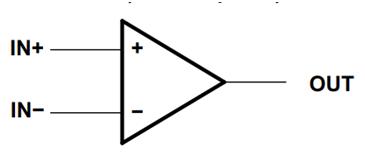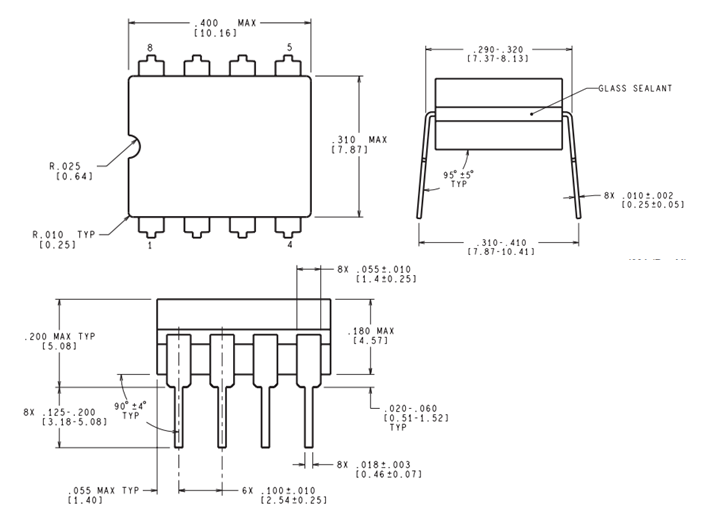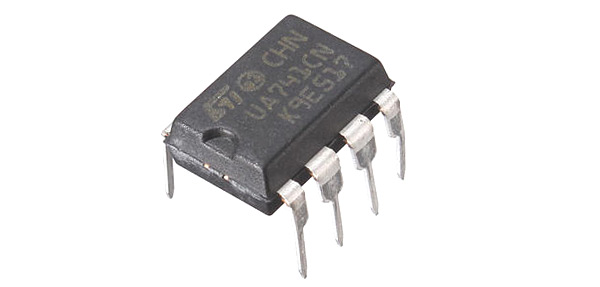UA741 General Purpose Op-Amp IC
UA741 Pin Configuration
|
Pin Number |
Pin Name |
Description |
|
1,5 |
Offset N1, N2 |
Used to set offset voltage if required |
|
2 |
Inverting Input (IN-) |
The Inverting pin of the Op-Amp |
|
3 |
Non- Inverting Input (IN+) |
The Non-Inverting Pin of the Op-Amp |
|
4 |
Vcc- |
Connected to negative rail or ground |
|
6 |
Output |
Output pin of the Op-Amp |
|
7 |
Vcc+ |
Connected to positive rail of supply voltage |
|
8 |
NC |
No connection |
UA741 Op-Amp Features and Specifications
- Supply Voltage: ±18V
- Differential Input Voltage: ±15V
- CMRR: 90dB
- Differential voltage amplification: 200V/mv
- Supply Current: 1.5mA
- Available in 8-Pin PDIP,SOIC and VSSOP packages
Equivalent for UA741
Alternatives Op-amps
LM4871, AD620, IC6283, JRC4558, TL081, LF351N, MC33171N
Where to use the UA741 Op-amp
If you have been into electronics for quite some time and have started with Op-Amps then you should have for sure come across the name UA741. It is a single package Op-Amp that has been widely used by engineers and students for quite a long time now. This Op-Amp can be used for many general purpose applications like, Voltage follower, Buffers, Comparators, Amplifiers, Adders and much more. So if you looking for a plain old Op-Amp just for some basic circuit design then this IC might be the right choice for you.
Although there are dozens of other Op-Amps with advanced technology, the UA741 still seems to be the first choice for many engineers because of its reliable properties
How to use UA741 IC
UA741 IC is very similar to the LM324 Op-Amp, and the LM324 can be considered as a successer for the UA741. The main difference is that LM324 has two Op-Amps inside package making to more cost effective and compact.If you are curious to learn about few application circuits of this IC then you can read through how LM324 is used since both the IC shares the same applications.
Other than that one notable unique feature of the UA741 Op-Amp is that it has two Offset pins (pin1 and pin 5). These two pins can be used to correct the offset error of an Op-Amp. That is when the voltage difference between the inverting and no-inverting pins are zero the output voltage of the Op-Amp should also be zero. If not then it is considered as offset error and it can be brought to zero again by providing a offset voltage through the offset pins that would nullify the error.
Op-Amp Design Considerations
The Op-Amps as we know are the work horse for most electronics circuit designs. There are a plethora of application circuits for Op-Amp each having its characteristics and significance in its own way. But every Op-Amp designs will have some common design considerations or tips which are common among them and we will discuss the same further.

Inputs: Op-Amps are known for its high input impedance, meaning it will not draw any current (or disturb) the signal that is being given to the Input pin. The input stage of an Op-Amp is mostly complex since it involves many stages. The Input common-mode range value must be considered while supplying voltage signals because the input voltage should never exceed the rail voltage else it will create a latch-up condition which in return will create a short circuit of the supply voltage and thus damaging the circuit permanently. Also the difference between the voltage values of the Inverting and the Non-Inverting pin should not be more than the Differential Input Voltage Rating.
Output: The UA741 is not a rail to rail Op-Amp hence the output voltage will not reach the maximum positive or maximum negative voltage when saturated. It will always be ~2V less than the supply voltage, this voltage drop occurs because of the Vce voltage drop of the transistors present inside the Op-Amp. Also remember that a saturated Op-Amp will comparatively draw more current and thus results in power loss.
Gain/Feedback: Op-Amps are known for their very large Open-Loop Gain, but sadly this gain is accompanied by noise hence most of the circuits are designed using Closed-Loop. A Closed-Loop system provides feedback to the input this limiting the gain value of the Op-Amp and the noise associated with it. A Negative feedback is commonly preferred, since it has predictable behaviour and stable operation.
Applications
- Audio mixers
- Portable music players
- Low Power Audio amplifiers
- Wienbridge oscillator
- DVD players and recorders
- Audio boosters
2D-Model and Dimensions















